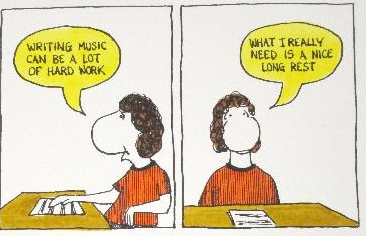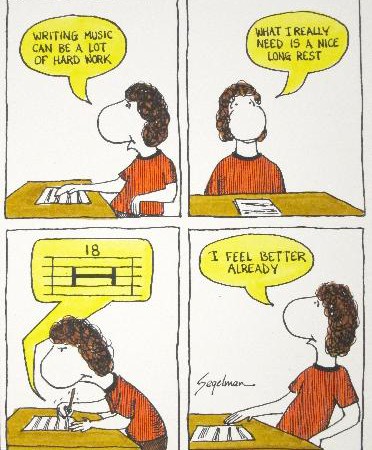
Below are the Write Like Mozart Week 6 Notes that I sent my students when we took the Write Like Mozart class together in 2014. In this post, I talk briefly about the rounded binary form.
This is the ninth post in this series.
For those of you who stuck with this course, congratulations! This was a pretty intense course.
In Dr. Edwards’ final three lessons, he analyzed a Mozart piece. He mentioned almost in passing the form of the piece that we analyzed, but this is a VERY IMPORTANT form. He calls it the Rounded Binary Form, and it is one of the earliest forms I introduce to my students who compose with me. Its structure is thus:
A – A’ – B – A’
The A and A’ are Question and Answer phrases. When composing with my youngest students, this is the first two phrase form I introduce. Sometimes we will write the answer phrase first, and then the question phrase.
The B section is a new phrase that is different from A, but it should be related in some way. For the B section, I encourage my students to explore reusing short motivic elements from A or some variation of those motifs. Sometimes reusing a short motivic element as a sequence or over multiple transpositions is enough. For variations, the motif might be inverted, or the rhythm might be applied to different notes (maybe forming a similar contour). Also consider what is to be different, if anything. In the analysis piece (the opening 18 bars of Sonata K. 331), Mozart’s material in the B section clearly is derivative of the material in the A sections. The opening motif is reused, and two distinct rhythmic motifs are reused. To differentiate, Mozart arpeggiates within the melody for the first time.
In completing the rounded binary, frequently the final A section is the same as the second A section. However, Mozart’s final A section differs from his initial A’: he adds a two measure extension after delaying the melodic arrival of the tonic. This is an important strategy of creating added interest. The listener expects that the final cadence arrives at the fourth bar of the phrase, but, by delaying arrival of the tonic, Mozart is able postpone the gratification of the cadence a bit longer and surprise the listener with the extension. Using a deceptive cadence is another common mechanism for delaying the arrival of the final cadence, but it would have been a less subtle mechanism than what Mozart did here.
One thing nice about the rounded binary form is that you end up with almost double the music that you actually compose. This is because the three A sections use most of the same music.
In the final assignment, the bar length required is an odd bar length that does not fit neatly into a rounded binary form. You will need to explore ways to extend or repeat your phrases. Perhaps you will want an introduction before the main melody starts, and perhaps you will add a coda. Consider the odd bar length to be an important seed of creativity that will push you outside of the square box of form and into the realm of surprising the listener and delaying the release of musical tension.
Good luck with your final assignment!

Copyright Mark Segelman. Used with permission.